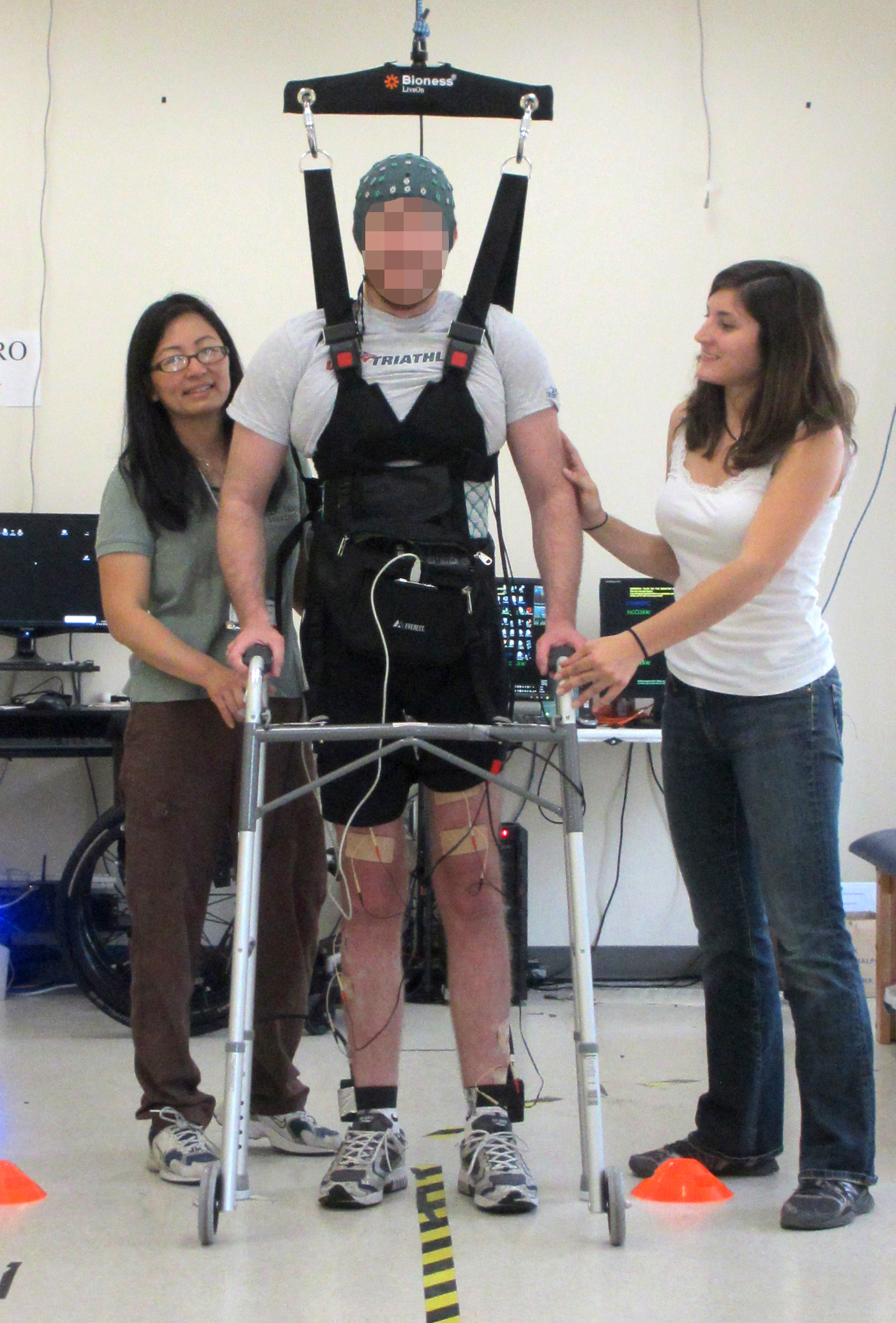Brain-computer interface enables paralyzed man to walk without robotic support
September 25, 2015

A BCI system allows a man whose legs had been paralyzed to walk without robotic support (credit: courtesy of UCI’s Brain Computer Interface Lab)
A novel brain-computer-interface (BCI) technology created by University of California, Irvine researchers has allowed a paraplegic man to walk for a short distance, unaided by an exoskeleton or other types of robotic support.
The male participant, whose legs had been paralyzed for five years, walked along a 12-foot course using an electroencephalogram (EEG) brain-computer-interface system that lets the brain bypass the spinal cord to send messages to the legs.
It takes electrical signals from the subject’s brain, processes them through a computer algorithm, and fires them off to electrodes placed around the knees that trigger movement in the leg muscles.
“Even after years of paralysis, the brain can still generate robust brain waves that can be harnessed to enable basic walking,” said UCI biomedical engineer Zoran Nenadic, an associate professor of biomedical engineering.
“We showed that you can restore intuitive, brain-controlled walking after a complete spinal cord injury. This noninvasive system for leg muscle stimulation is a promising method and is an advance of our current brain-controlled systems that use virtual reality or a robotic exoskeleton.”
Study results of this preliminary proof-of-concept study appear in an open-access paper in the Journal of NeuroEngineering & Rehabilitation. The research was supported by a National Science Foundation grant.
Training and therapy process
Months of mental training to reactivate the brain’s walking ability and physical therapy were needed for the study participant to reach the stage where he could take steps. Wearing an EEG cap to read his brain waves, he was first asked to think about moving his legs. The brain waves this created were processed through a computer algorithm designed to isolate brain signals specifically related to leg movement.
The subject was first trained to control an avatar in a virtual reality environment, which validated the specific brain wave signals produced by the algorithm. This training process yielded a custom-made system, Nenadic said, so that when the participant sought to initiate leg movement, the computer algorithm could process the brain waves into signals that could stimulate his leg muscles.
UCI | Person with Paraplegia Uses a Brain-Computer Interface to Regain Overground Walking
To make this work, the subject required extensive physical therapy to recondition and strengthen his leg muscles. Then, with the EEG cap on, he practiced walking while suspended 5 centimeters above the floor, so he could freely move his legs without having to support himself. Finally, he translated these skills to the ground, wearing a body-weight support system and pausing to prevent falls.
Since this study involved a single patient, further research is needed to establish whether the results can be duplicated in a larger population of individuals with paraplegia, said An Do, a neurologist and an assistant clinical professor of neurology.
“Once we’ve confirmed the usability of this noninvasive system, we can look into invasive means, such as brain implants,” she said. “We hope that an implant could achieve an even greater level of prosthesis control because brain waves are recorded with higher quality. In addition, such an implant could deliver sensation back to the brain, enabling the user to feel his legs.”
Abstract of The feasibility of a brain-computer interface functional electrical stimulation system for the restoration of overground walking after paraplegia
Background: Direct brain control of overground walking in those with paraplegia due to spinal cord injury (SCI) has not been achieved. Invasive brain-computer interfaces (BCIs) may provide a permanent solution to this problem by directly linking the brain to lower extremity prostheses. To justify the pursuit of such invasive systems, the feasibility of BCI controlled overground walking should first be established in a noninvasive manner. To accomplish this goal, we developed an electroencephalogram (EEG)-based BCI to control a functional electrical stimulation (FES) system for overground walking and assessed its performance in an individual with paraplegia due to SCI.
Methods: An individual with SCI (T6 AIS B) was recruited for the study and was trained to operate an EEG-based BCI system using an attempted walking/idling control strategy. He also underwent muscle reconditioning to facilitate standing and overground walking with a commercial FES system. Subsequently, the BCI and FES systems were integrated and the participant engaged in several real-time walking tests using the BCI-FES system. This was done in both a suspended, off-the-ground condition, and an overground walking condition. BCI states, gyroscope, laser distance meter, and video recording data were used to assess the BCI performance.
Results: During the course of 19 weeks, the participant performed 30 real-time, BCI-FES controlled overground walking tests, and demonstrated the ability to purposefully operate the BCI-FES system by following verbal cues. Based on the comparison between the ground truth and decoded BCI states, he achieved information transfer rates >3 bit/s and correlations >0.9. No adverse events directly related to the study were observed.
Conclusion: This proof-of-concept study demonstrates for the first time that restoring brain-controlled overground walking after paraplegia due to SCI is feasible. Further studies are warranted to establish the generalizability of these results in a population of individuals with paraplegia due to SCI. If this noninvasive system is successfully tested in population studies, the pursuit of permanent, invasive BCI walking prostheses may be justified. In addition, a simplified version of the current system may be explored as a noninvasive neurorehabilitative therapy in those with incomplete motor SCI.